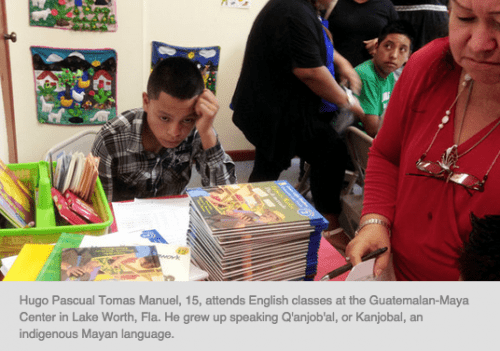
What’s Happening in American Communities Where Illegal Alien Families Land?
03/30/2019
There has been a surprising dearth of news stories about what happens to the local communities of America when crowds of unlawful foreigners arrive from crossing the open border and need social services.
In earlier mass intrusions, such as during Obama’s big welcome, there were news stories about the financial and other burdens on local citizens which was reported here: Lynn, Massachusetts, ‘On the Brink’ from Dumped Illegal Alien Kid Costs and Chelsea Massachusetts Provides Preview of School Strains for Dumped Alien Kids, plus Illegal Alien Kids Stress New York City Schools to show it wasn’t just Massachusetts getting hit in 2014.

Here is a little detail about the costs from that time:
Educating backward children from the Third World is an expensive project. One example is Lynn Massachusetts, where the mayor had to rejigger the entire budget by reducing funds to city departments to pay for the extra costs of 600 illegal kids. Those needs include free food, tutors, Spanish-speaking teachers, psychological counseling and healthcare. Some of the little aliens don’t even understand Spanish but were raised speaking indigenous languages like Kanjobal or Ixil. Some have never attended school at all.
And remember — either taxes are increased to support the needy non-English speakers or government services for citizens are cut.
Back to news coverage, illegal alien cost stories are curiously rare compared to a few years ago. Is the press reticent because its pals the Democrats support the open borders funneling in thousands of illegal kiddies? It is odd.
Here’s a story from Long Island, far from the border. Click for video.
7 On Your Side Investigates: Long Island district struggles to serve surge in migrant students, ABC7 New York, March 29, 2019
RIVERHEAD, Long Island (WABC) — For Mrs. Pamela Joyce, a school counselor in the Riverhead Central School District, each day brings more to do than she could ever fit into 24 hours.
She describes working weekends, staying late, and coming to school early, in the hopes of reaching the hundreds of kids she serves between the district’s high school and middle school.
Joyce is the district’s only bilingual school counselor for the high school and middle school. She’s also the only counselor the district has added in the last decade despite a quickly climbing student population.
She splits her time between both campuses and often encounters kids with little to no understanding of the U.S. education system.
“To be the kid in the foreign country who didn’t have shoes, who moved here and their life is so different, every day there is something to catch up on,” Joyce said.
Joyce serves students considered English language learners.
Eyewitness News attended a group session as Joyce prepared 8th graders for high school.
Joyce said there are many kids she just can’t reach because she doesn’t have the time.
“I actually have four new students to schedule this week,” Joyce said, “so they don’t stop coming.”
“We have not kept up,” added Superintendent Dr. Aurelia Henriquez who said hospitalizations for mental health issues and other behavioral concerns have climbed as the district struggles to reach its kids.
“We can’t implement the programs and the staff that we know our children and our district needs,” Henriquez said.
The district has one of the highest rates of agricultural migrant students in New York.
In Riverhead, the number of kids who don’t have a good grasp of English has more than doubled over the past five years, outpacing the state and county averages according to New York State Education Department enrollment data.
However, state funding hasn’t kept up with the district’s increasing needs.
Instead, the state has shortchanged Riverhead by nearly $25 million in funding known as Foundation Aid in an effort to save money.
The New York legislature created the Foundation Aid formula over a decade ago in an effort to increase equity in schools across New York by sending more money to needy districts, but it has repeatedly failed to entirely follow that formula or fully fund it in an effort to save money, leaving many districts with a fraction of their needs. (Continues)
